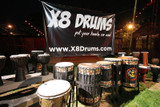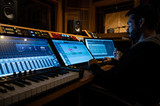Djembes and Drums for Modern Worship? YES!
Plenty of people consider the djembe drum a staple instrument in drum circles or in performances that highlight African culture. These popular hand drums are also responsible for exciting experiences in schools, for motivating employees in team building exercises and forging connections within communities. So, why is it so shocking to see a djembe drum in a place of worship?
For many, it isn’t; djembe drums are just another musical way to worship.
Back in the day, djembe drums served a variety of purposes in West Africa. They were used as tools of communication, as well as for celebrating milestones within a tribe like weddings or the birth of a baby. Djembe drums held (and still hold) a very spiritual connection in tribal customs, and were mainstays in religious ceremonies as well as to aspects of nature they revered. The nature of a djembe drum continues to provide this same connection with earth-based religions and in spiritual ceremonies around the world, and more and more, they’re also popping up in churches and other places of worship.
Drums in a church may seem out of place, but more and more churches are trying to attract younger members and have a more “modern” feel than in years prior. Drums bring a “rock and roll” vibe to the music, or integrate a Latin or African groove. On the other hand, drums can be very loud, whether we’re talking about a djembe or a drum set, and churches are often considered places of respite and contemplation. But, if you consider the way drumming can lift one’s “emotional” spirit, the addition of drums in a church is just another way to encourage members to worship.
Since smaller churches have space considerations, a drum set may simply be too big to fit, not to mention the volume and acoustical challenges. Djembe and other hand drums are perfect in most intimate church settings since a djembe drum can be softly added to favorite church hymns and secular music with ease, providing a soft rhythm when needed or a more powerful beat that grabs the attention of everyone.
All cultures have a tradition of drumming or the use of percussion instruments. Biblically, Miriam played the tambourine for Moses, and plenty of people can understand the concept of “making a loud noise” by using drums in worship. After all, even clapping your hands together is percussion, and all songs have a beat. Why not add a little flavor to the spiritual groove with a little djembe drumming?
Of course, there are those who still believe that drums, in particular, hold a pagan or demonic connection that cannot be used in a church. These beliefs are much like those that were held during the years of slave trading where the “owners” of African men and women would destroy and ban their native drums out of fear and a need for control. Considering drums like the cajon were developed in response to the elimination of native drums and drumming traditions, we cannot help but notice a similar “uprising” in the presence of drums in the more modern churches.
If you ask any drummer, they understand the connection felt when playing their instrument, no matter the drums they own. You “get” that connection, too, when you’re tapping your toes to your favorite song on the radio. It’s all because of the beat, the rhythm and the connection that is felt deep within… that very same feeling many people get in church. If you really think about it, it isn’t as shocking to see drums in a church these days as the absence of drums, and we cannot wait to see how many more “modern” churches get their own groove going… just by adding some drums!
Recent Posts
-
Integrating Djun Djun into Modern Music: A Guide for Musicians
What is Djun Djun in modern music? Djun Djun, a type of drum originating from West Africa, is comm …21st Apr 2024 -
Incorporating the Thumb Piano into Modern Music Production
Introduction to the Thumb Piano The thumb piano, also known as the Kalimba or Mbira, is a small …15th Apr 2024 -
The Top 5 Djembes for Beginners: A Buyer's Guide
What is a Djembe? A Djembe is a type of drum originating from West Africa, traditionally made from …13th Apr 2024



